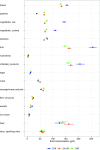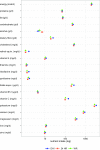Comparison of food consumption and nutrient intake assessed with three dietary assessment methods: results of the German National Nutrition Survey II
- PMID: 29189903
- PMCID: PMC6424917
- DOI: 10.1007/s00394-017-1583-z
Comparison of food consumption and nutrient intake assessed with three dietary assessment methods: results of the German National Nutrition Survey II
Abstract
Purpose: Comparison of food consumption, nutrient intake and underreporting of diet history interviews, 24-h recalls and weighed food records to gain further insight into specific strength and limitations of each method and to support the choice of the adequate dietary assessment method.
Methods: For 677 participants (14-80 years) of the German National Nutrition Survey II confidence intervals for food consumption and nutrient intake were calculated on basis of bootstrapping samples, Cohen's d for the relevance of differences, and intraclass correlation coefficients for the degree of agreement of dietary assessment methods. Low energy reporters were identified with Goldberg cut-offs.
Results: In 7 of 18 food groups diet history interviews showed higher consumption means than 24-h recalls and weighed food records. Especially mean values of food groups perceived as socially desirable, such as fruit and vegetables, were highest for diet history interviews. For "raw" and "cooked vegetables", the diet history interviews showed a mean consumption of 144 and 109 g/day in comparison with 68 and 70 g/day in 24-h recalls and 76 and 75 g/day in weighed food records, respectively. For "fruit", diet history interviews showed a mean consumption of 256 g/day in comparison with 164 g/day in 24-h recalls and 147 g/day in weighed food records. No major differences regarding underreporting of energy intake were found between dietary assessment methods.
Conclusions: With regard to estimating food consumption and nutrient intake, 24-h recalls and weighed food records showed smaller differences and better agreement than pairwise comparisons with diet history interviews.
Keywords: 24-h recalls; Diet history interviews; Food consumption; Nutrient intake; Underreporting; Weighed food records.
Conflict of interest statement
On behalf of all authors, the corresponding author states that there is no conflict of interest.
Figures
Similar articles
-
Comparison of two dietary assessment methods by food consumption: results of the German National Nutrition Survey II.Eur J Nutr. 2015 Apr;54(3):343-54. doi: 10.1007/s00394-014-0714-z. Epub 2014 May 15. Eur J Nutr. 2015. PMID: 24829069
-
Trends in food consumption and nutrient intake in Germany between 2006 and 2012: results of the German National Nutrition Monitoring (NEMONIT).Br J Nutr. 2016 Apr;115(8):1498-507. doi: 10.1017/S0007114516000544. Epub 2016 Mar 3. Br J Nutr. 2016. PMID: 26934826
-
Meat consumers and non-meat consumers in Germany: a characterisation based on results of the German National Nutrition Survey II.J Nutr Sci. 2019 Jun 7;8:e21. doi: 10.1017/jns.2019.17. eCollection 2019. J Nutr Sci. 2019. PMID: 31217969 Free PMC article.
-
Misreporting of energy and micronutrient intake estimated by food records and 24 hour recalls, control and adjustment methods in practice.Br J Nutr. 2009 Jul;101 Suppl 2:S73-85. doi: 10.1017/S0007114509990602. Br J Nutr. 2009. PMID: 19594967 Review.
-
National Nutrition Surveys Applying Dietary Records or 24-h Dietary Recalls with Questionnaires: A Scoping Review.Nutrients. 2023 Nov 9;15(22):4739. doi: 10.3390/nu15224739. Nutrients. 2023. PMID: 38004132 Free PMC article.
Cited by
-
A Web-Based 24-H Dietary Recall Could Be a Valid Tool for the Indicative Assessment of Dietary Intake in Older Adults Living in Slovenia.Nutrients. 2019 Sep 16;11(9):2234. doi: 10.3390/nu11092234. Nutrients. 2019. PMID: 31527530 Free PMC article.
-
Longitudinal Nutritional Intakes in Italian Pregnant Women in Comparison with National Nutritional Guidelines.Nutrients. 2022 May 5;14(9):1944. doi: 10.3390/nu14091944. Nutrients. 2022. PMID: 35565911 Free PMC article. Clinical Trial.
-
Intakes of energy, macronutrients, and micronutrients in adult Lithuanian population: a national study of 2019-2020.J Nutr Sci. 2024 Sep 23;13:e46. doi: 10.1017/jns.2024.40. eCollection 2024. J Nutr Sci. 2024. PMID: 39469191 Free PMC article.
-
Relationship between sleep quality and dietary nutrients in rural elderly individuals: a latent class analysis.Front Nutr. 2025 Jan 20;12:1479614. doi: 10.3389/fnut.2025.1479614. eCollection 2025. Front Nutr. 2025. PMID: 39902312 Free PMC article.
-
The impact of long working hours on daily sodium intake.Ann Occup Environ Med. 2024 Apr 1;36:e9. doi: 10.35371/aoem.2024.36.e9. eCollection 2024. Ann Occup Environ Med. 2024. PMID: 38741680 Free PMC article.
References
-
- Thompson FE, Subar AF. Dietary assessment methodology. In: Coulston AM, Boushey CJ, Ferruzzi MG, editors. Nutrition in the prevention and treatment of disease. 3. Oxford: Elsevier; 2013. pp. 5–46.
-
- van Staveren WA, Ocké MC, de Vries JHM. Estimation of dietary intake. In: Erdman JW, Macdonald IA, Zeisel SH, editors. Present knowledge in nutrition. 10. Ames: Wiley-Blackwell; 2012. pp. 1012–1026.
-
- de Boer EJ, Slimani N, Van TV, Boeing H, Feinberg M, Leclercq C, Trolle E, Amiano P, Andersen LF, Freisling H, Geelen A, Harttig U, Huybrechts I, Kaic-Rak A, Lafay L, Lillegaard IT, Ruprich J, de Vries JH, Ocké MC. The European Food Consumption Validation Project: conclusions and recommendations. Eur J Clin Nutr. 2011;65(suppl. 1):S102–S107. doi: 10.1038/ejcn.2011.94. - DOI - PubMed
Publication types
MeSH terms
LinkOut - more resources
Full Text Sources
Other Literature Sources



